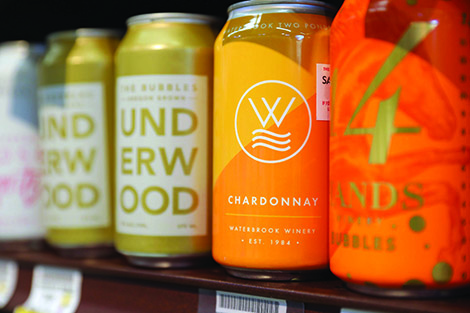A few years ago, Washington’s wine industry pushed the belief that high-quality wines should come in a heavy glass bottle with a wooden cork closure and wrapped with aluminum or tin foil capsules on top. But individual wineries are challenging those notions as they seek to reach a new generation of wine drinkers willing to forgo tradition and address environmental sustainability and supply chain issues. The result: Wine drinkers can also enjoy good-tasting, high-quality wine that comes in a bag-in-a-box or in a can. And the traditional wine bottle is getting a revamp, too.
Seattle-based Full Pull Wines, which reaches customers through its e-mail newsletter, has featured wine in cans and bag-in-a-box formats, along with traditional glass bottles. Owner Paul Zitarelli said many of its customers have been drawn to the bag-box concept, namely because of its light construction, which makes it easy to transport to parties and other events.
“Whether it’s a can, box, or light glass bottle, ultimately, it’s what’s inside that counts,” he said.
Gavin Sacks, a food science professor at Cornell University, has researched wine quality when it’s stored in various containers and found that there are challenges — and advantages —in alternative packaging. The seams of a bag-in-a-box wine, for example, often allow more oxygen to enter, which shortens the amount of time the wine can be consumed to just a few months. That’s not ideal for wineries that need to store product for a long time or package wine just a handful of times a year, Sacks said.
However, the difference in wine oxidation when the package is closed and when it’s open is minimal, which allows for consumption for a longer period of time once a package is opened. An open bottle stays fresh for a few weeks at best, but a bag-in-a-box wine can be consumed for several months after opening.
Sacks is a proponent of cans, as they can keep oxygen out and be stored for a long time. Cans do have their own issues, however. Some sulfated wines, when they come in contact with cans, create a chemical compound that causes an unpleasant smell akin to rotten eggs. And sometimes, cans corrode and leak.
Sacks is studying whether there is a way to prevent the quality issue — maybe by adding a plastic liner or limiting the use of cans to unaffected wine varieties.
In addition, canning is a specialized process, and oxygen can get into the wine during canning if done improperly and ruin it.
Generally, wineries that want to try canning often do it through a third party, not only because they don’t have a canning line, but also because they lack experience in the process itself, Sacks said. The 14 Hands cans, for example, are bottled by Schilling Cider in Auburn.
A law passed in 2022 by the Legislature will allow wineries to go to any alcoholic beverage provider, with a certain endorsement, to do canning. That includes breweries. Previously, wineries were limited to working with other wineries, including cideries, which were considered part of the same beverage category.
Even those who have been proponents of change said there’s still appeal in traditional glass bottles with a wooden cork closure. Some wine drinkers still prefer it.
Source: Crosscut, a non-profit Northwest journalism site that is part of Cascade Public Media.
